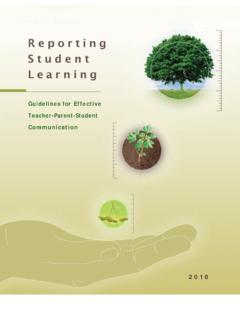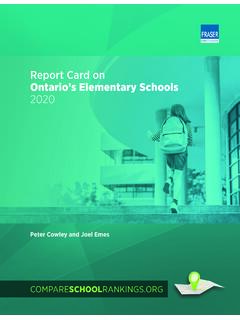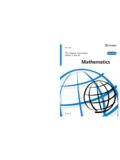Transcription of The Relationship between Educational Resources of School ...
1 International Education Studies; Vol. 6, No. 4; 2013 ISSN 1913-9020 E-ISSN 1913-9039 Published by Canadian Center of Science and Education 114 The Relationship between Educational Resources of School and Academic Achievement Havva Sebile SAVASCI1 & Ekber TOMUL2 1 Isaabat Primary School , Provincial Directorate of National Education, Tutak, Agr , Turkey 2 Faculty of Education , Mehmet Akif Ersoy University, 15100-Burdur, Turkey Correspondence: Ekber TOMUL, Faculty of Education, Mehmet Akif Ersoy University, 15100-Burdur, Turkey. Tel: 90-248-213-4047. E-mail: Received: March 4, 2013 Accepted: March 8, 2013 Online Published: March 13, 2013 URL: Abstract The Educational Resources of schools play an important role in order to diminish the effect of socioeconomic features on academic achievement, and create equal opportunities for students.
2 In this sense, it is highly crucial to investigate the Relationship between the Educational Resources of schools and the academic achievement of students. This study aims to determine the Relationship between the academic achievement level of 7th grade students and the Educational Resources of schools. The population of the study was the elementary schools in the province of Burdur in 2007-2008 academic years. Two-stage cluster sampling was conducted in conformity with the aim of the study. First, settlements were chosen with geographical cluster sampling.
3 As settlement, city centers, town centers, small towns and villages were considered in the study. Considering the Relationship between the Educational Resources of the schools and the academic achievement as a whole, there are negative and significant relationships between the SBS scores of the students, and the average service length of the teachers, the lack of qualified science teachers, the lack of qualified Turkish teachers, the lack of the teachers in other courses and the lack of the laboratory technicians. It can be said that there is a Relationship between the Educational Resources and academic achievement.
4 However, this Relationship is fairly limited. It is still not possible to say that the Educational Resources do not have the strength to diminish the effect of the socioeconomic features. Keywords: inequality, Educational Resources , academic achievement, equal opportunities 1. Introducation It is endorsed that academic achievement of students is related to individual differences between students, socioeconomic features in which they grow up, and Educational Resources of students current School . The Relationship between socioeconomic features and academic achievement has been extensively studied within national and international context in recent years (Tomul & Savasci, 2012).
5 However, there is a dearth of the studies about the Relationship between Educational Resources of School and academic achievement. Educational Resources are of vital importance in terms of its role in attaining Educational aims and objectives. In this sense, Educational Resources play a significant role in order to provide equal opportunities for students by diminishing the effect of socioeconomic factors on academic achievement. The level of attaining Educational aims and objectives is directly related to Educational Resources and use of them. The role of schools in academic achievement has been investigated in many countries since the equality of Educational opportunity report in the year of 1966 in USA (Rivkin, Hanushek & Kain, 2005).
6 There are, in fact, different results for the studies that investigate the Relationship between Educational Resources of schools and academic achievement. Some studies indicate that Educational Resources of schools do not have an effect on academic achievement of students (Hanushek, 1997; Hanushek & Luque, 2003; Hakkinen et al., 2003). On the other hand, some studies say the exact opposite (Card & Krueger, 1996; Greenwald, Hedges & Laine, 1996). Card and Krueger (1996), Greenwald and et al. (1996), Fuller and Clarke (1994), and Heyneman and Loxley (1983) recognize the effect of physical and economic Resources on achievement.
7 Physical Resources can be categorized under the headings of people, equipment, physical and economic Resources . According to the analysis of Ferreira and Gignoux (2010) based on the data of PISA 2006, family and School conditions account International Education Studies Vol. 6, No. 4; 2013 115 for at least 26% of Turkish and mathematics scores and 27% of science scores of students. In Demir s (2009) study, variables about School only accounts for of variance. There are some studies which indicate that the effect of Educational Resources on student achievement depends on the development level of a country, as well.
8 To account for academic achievement of students, factors related to School is more effective in developing countries, and social background of students is more effective in developed countries (Fuller & Clarke, 1994; Heyneman & Loxley, 1983). Adeogun and Osifila (2008) found that there are positive relationships between academic achievement of students and physical, financial and material Resources . However, human Resources are found not to be significantly related to students academic performance. In PISA (Ministry of National Education, 2003) report, it is shown that the lack of physical Resources has a negative effect on students, and it hinders learning of students.
9 In developing countries, the Relationship between student achievement, and student-teacher ratio, education level of teachers and School facilities is more apparent than in developed countries. Nevertheless, it is not right to mention about a strong Relationship within this context (W mann, 2003; Hanushek, 2006). Furthermore, developing countries trail developed countries in terms of Educational Resources such as student-teacher ratio, teachers level of education and School facilities. As a consequence, developing countries trail developed countries in terms of academic achievement on an international scale (Glewwe & Kremer, 2006).
10 Considering these results, W mann (2003) suggests that Educational Resources have a diminishing effect on academic achievement. According to the study of Hanushek (1986, 1997) on the Relationship between student-teacher ratio, education level of teachers and School facilities, and student achievement, there is a poor relation between Educational Resources and student achievement. Somers (2001) reported positive effects of student-teacher ratio, Educational materials, library size, and teacher education on learning outputs. For effective learning, some studies in low-income countries emphasize the significance of human and financial Resources that include subconstruction of schools, classroom size, teacher experiences, teacher abilities, and Educational materials (Fuller & Clarke, 1994; Heyneman & Loxley, 1983).















